AFRL/AFOSR to conduct rocket launch at NASA Wallops for hypersonics research
WRIGHT-PATTERSON AIR FORCE BASE, Ohio (AFRL) – A launch of a two-stage suborbital sounding rocket for the Air Force Research Laboratory/Air Force Office of Scientific Research’s BOLT II flight experiment is set to take place the evening of March 21 at the National Aeronautics and Space Administration (NASA) Wallops Flight Facility in Virginia.
Live coverage of the launch will be provided on NASA Wallops YouTube channel. Officials at NASA Wallops project the launch to be visible anywhere from 10 to 120 seconds from parts of seven states: Virginia, Maryland, Delaware, New Jersey, North Carolina, Pennsylvania, and West Virginia as well as Washington, D.C.
The goals of the AFRL/AFOSR BOLT flight experiments are to collect scientific data to better understand Boundary Layer Transition (BOLT) and Turbulence (BOLT II) during hypersonic flight. Specifically, the desire is to better enable prediction and control of viscous drag and heating on hypersonic vehicles. “Boundary layer transition and turbulence are both complex phenomena that are very difficult to study because we cannot replicate [these conditions] very well on the ground,” said Dr. Sarah Popkin, who oversees BOLT II as AFOSR’s Program Officer for High-Speed Aerodynamics.
“Turbulent flow drives up the heat over the largest portion of the vehicle,” Popkin said. “There’s a lot of heat that happens right at the very leading edge, but that’s all in a very focused area. Turbulence can cause heat to evolve over almost the entire vehicle surface, and so now you’re having to worry about protecting internal electronics and things like that, from that heat, and being able to understand and predict the turbulence associated with the heating will help us design better hypersonic vehicles. Heat is the mother of all problems for hypersonics.”
While the BOLT I transition flight experiment did not perform as hoped, Popkin said that everything they learned from the telemetry data collected has been analyzed for BOLT II by several organizations. Like its predecessor, BOLT II benefits from a multi-collaborative approach involving government, academia and industry organizations, with many of the same players, using simulations, ground testing and flight data. Texas A&M University (TAMU), which had consulted on BOLT I, led the science mission as the principal investigator organization on BOLT II, with Dr. Rodney Bowersox, professor of aerospace engineering, serving as lead PI.
“Dr. Popkin was all over the flight stability, wanting to know exactly what happened [with BOLT I] to help avoid repeating for BOLT II,” said Bowersox. “There was a tremendous amount of flight stability work that took place in the design of the BOLT II flight system.” Because of the atypical geometry, a close collaboration between the Department of the Air Force, TAMU, CUBRC, and the NASA teams was required. TAMU graduate students provided computational fluid dynamics aerodynamic database of the full rocket stack, which was the input for the flight stability analyses carried out by NASA Wallops. “The NASA team really held our feet to the fire in terms of flight stability,” commented Bowersox.
A John Hopkins University Applied Physics Laboratory (JHUAPL) team, led by Dr. Brad Wheaton, who also served as the principal investigator on BOLT I, spot-checked the students’ analysis on BOLT II, as well as examined the flight stability of BOLT II with the lessons learned from BOLT I.
“There’s been a lot of people looking at this, looking at the approach, looking at the design,” said Raymond “Jim” Lanzi, chief engineer for NASA’s Sounding Rockets Program Office.
Strategic partnerships are vital to AFRL/AFOSR’s basic research success. By creating and supporting opportunities for highly diversified partnerships such as these, AFRL/AFOSR can also provide important ways to build the next generation of scientists and engineers who can solve difficult problems and contribute to modernizing the future science and technology needs for the nation.
“In Memory of Mike Holden”
CUBRC, which handled the first wind tunnel testing and built the full-scale model for BOLT I, partnered with TAMU and led the fabrication and ground test efforts on BOLT II. CUBRC’s Dr. Aaron Dufrene elaborated, referencing late vice president of CUBRC’s Aerosciences Group, Dr. Michael Holden, who, up until his passing in 2019, had been a leader in the hypersonics field since the 1960s and to whom BOLT II’s flight is dedicated.
“[Mike] was a very fundamentally grounded physics person and wanted to see a connection from ground test experiments to fight experiments. That’s how he really saw how we could move the ball forward in hypersonics. We have the unique opportunity to test the vehicle in the wind tunnel at several different conditions with flight instrumentation flight hardware, and then go out and fly it,” Dufrene said. “Those same sensors that we’re getting data on in the tunnel, we’re going to be able to compare to in flight. It’s the first time anything like that’s ever happened, and it’s going after a problem that’s near and dear to Mike’s heart that he spent 55 years chasing.”
In light of the recent Olympics, Dufrene mentioned how, in 1980, Holden once went after another problem surrounding something else near and dear to his heart: skiing and America’s all-time lack of an Olympic downhill skiing gold medal. During the Lake Placid Olympics, he approached U.S. Olympic officials and offered his then company, Calspan’s, old low-speed wind tunnel test facility for training Winter Olympic athletics. He volunteered many weekends to help skiers test aerodynamic drag of different body positions and gear in real time in hopes of improving future race times, leading to the first ever American downhill skiing gold medal in the 1984 Sarajevo Olympics and to ski jumpers, lugers and speedskaters training in the facility thereafter.
In addition to CUBRC’s ground testing on BOLT II, an international collaboration has enabled the University of Queensland to carry out a second full-scale wind tunnel test campaign, and the Australian Defence Science and Technology Group provided flight computers to match its BOLT I contribution.
NASA leads the integration of the research test article and flight system. They provided a low-cost two-stage sounding rocket launch option and integrated into the payload their mature telemetry, electronics, and trajectory tracking systems.
This was an incredible team effort,” said Bowersox. “The entire community participated in the design and reviews leading to up to the flight test. This community is watching. The other element that worked very well was the extensive participation by students at TAMU and other universities on BOLT II, especially in the science mission design phase. They were integral to making the program happen.”
Together with TAMU’s system, the BOLT II payload includes 400-plus sensors and instruments. The TAMU graduate students designed instrumentation layouts and extensions to hardware and provided the aerodynamic database simulations required for flight trajectory design and heat transfer calculations.
Heather Kostak led the student effort as a TAMU aerospace engineering student whose master’s thesis and doctoral dissertation centered on BOLT I and II, respectively. She said BOLT gave her the opportunity to collaborate with people and organizations outside of TAMU, such as University of Minnesota and Purdue University, as well as industry, such as CUBRC and JHUAPL, and government with NASA Langley.
“Just getting the intel and being able to see where these different groups participate, where it’s really unique to see everyone come together and solve problems,” Kostak said. “Also putting a lot of faith in the students is amazing because I think team learned from students, while the students were learning from outside of academia.”
“I cannot say enough good things about Rodney’s graduate students Bryan Morreale and Eric Swinny,” said NASA’s Lanzi, “for the work they put in on the aerodynamics analysis — Just the diligence. They did a real service to the project, responding to all the different configuration changes.”
Also contributing to the BOLT II university and government efforts, several stratospheric teams are providing weather data ahead of the launch and measuring atmospheric conditions during the launch to aid the understanding of turbulence, specifically to include NASA providing weather related safety data. Involved in the efforts are a small team of Air Force Life Cycle Management Center (AFLCMC) atmospheric scientists and the Department of Defense’s Multidisciplinary University Research Initiative (MURI) team that includes University of Colorado Boulder’s Hypersonic Flight in the Turbulent Stratosphere team (HYFLITS), University of Minnesota and Embry-Riddle Aeronautical University, supported by the AFRL/AFOSR basic research High-Speed Aerodynamics program.
Mary Bedrick, the AFLCMC team’s lead atmospheric scientist said that part of determining the aerodynamics of a flight body is how the atmosphere is impacting it. So, one of the parameters they try to compute is the dynamic pressure, basically, how much air is the body encountering? And part of what goes into that computation is atmospheric density. With the post-flight analysis, we’re trying to help them determine what impact the atmosphere is having on the flight. The other thing that we’re going to try to do afterward is help give a grand view of all the weather data that is observed, not only for the flight itself, but before and after.”
“One of the things you need to remember is that the stratosphere is traditionally under-sampled; you don’t have that background of information to know what to expect. So, any information you get, it fills in some gaps; every new piece of data you get you learn something from. HYFLITS and the rest [of the team] are helping fill in that that gap.”
The HYFLITS/MURI team will be taking measurements of the atmosphere and stratosphere during the BOLT II launch by launching two high-altitude, helium-filled two-meter-diameter balloons with sensors attached before launch, two after launch as well as 16 other balloons in the days leading up to launch. The goal is to measure background conditions the vehicle is flying through, the turbulence intensity on the balloons and particulate concentrations, because these things have been shown to have some impact on the boundary layer transition on the vehicle, said Dr. Dale Lawrence, professor of aerospace engineering and director of the Research and Engineering Center for Unmanned Vehicles at Colorado-Boulder.
Popkin said that working with a multi-faceted team has been complex but rewarding. “Seeing all these people come together and share thoughts and learn each other’s technical challenges and contributions has been really fun to watch, especially the stratospheric team,” she said. “They’re all trying to culminate sort of in and around this launch, which has its own set of problems, its own set of challenges, and I think it’s just been fruitful,” said Popkin. “I’m very proud of how it’s all come together.”
BOLT II exemplifies just how AFRL/AFOSR continues to discover, shape and champion bold, high risk, high reward basic research for the United States Air Force and Space Force. As AFRL/AFOSR celebrates 70 years of innovation, this legacy continues through smart investments in basic research opportunities that take deep dives into scientific transformational principles and conceptions that clear the path to new inventions, products and capabilities. As well, BOLT II illustrates the importance of basic research as a long-term investment that requires commitment and a sound strategy.
Please note: The NASA Visitor Center at Wallops will not be open for viewing the launch. In case of inclement weather, the launch may be rescheduled for some time between March 22 and April 1.
About AFOSR
The Air Force Office of Scientific Research (AFOSR) expands the horizon of scientific knowledge through its leadership and management of the Department of the Air Force’s basic research program. As a vital component of the Air Force Research Laboratory (AFRL), AFOSR’s mission is discover, shape and champion basic research that profoundly impacts the future Air and Space Forces. AFOSR accomplishes its mission through global investment in advanced discovery research efforts in relevant scientific areas. Central to AFOSR’s strategy is the transfer of the fruits of basic research to industry, the supplier of Department of Air Force acquisitions; to the academic community, which can lead the way to still more accomplishment; and to the other directorates of AFRL that carry the responsibility for applied research leading to acquisition.
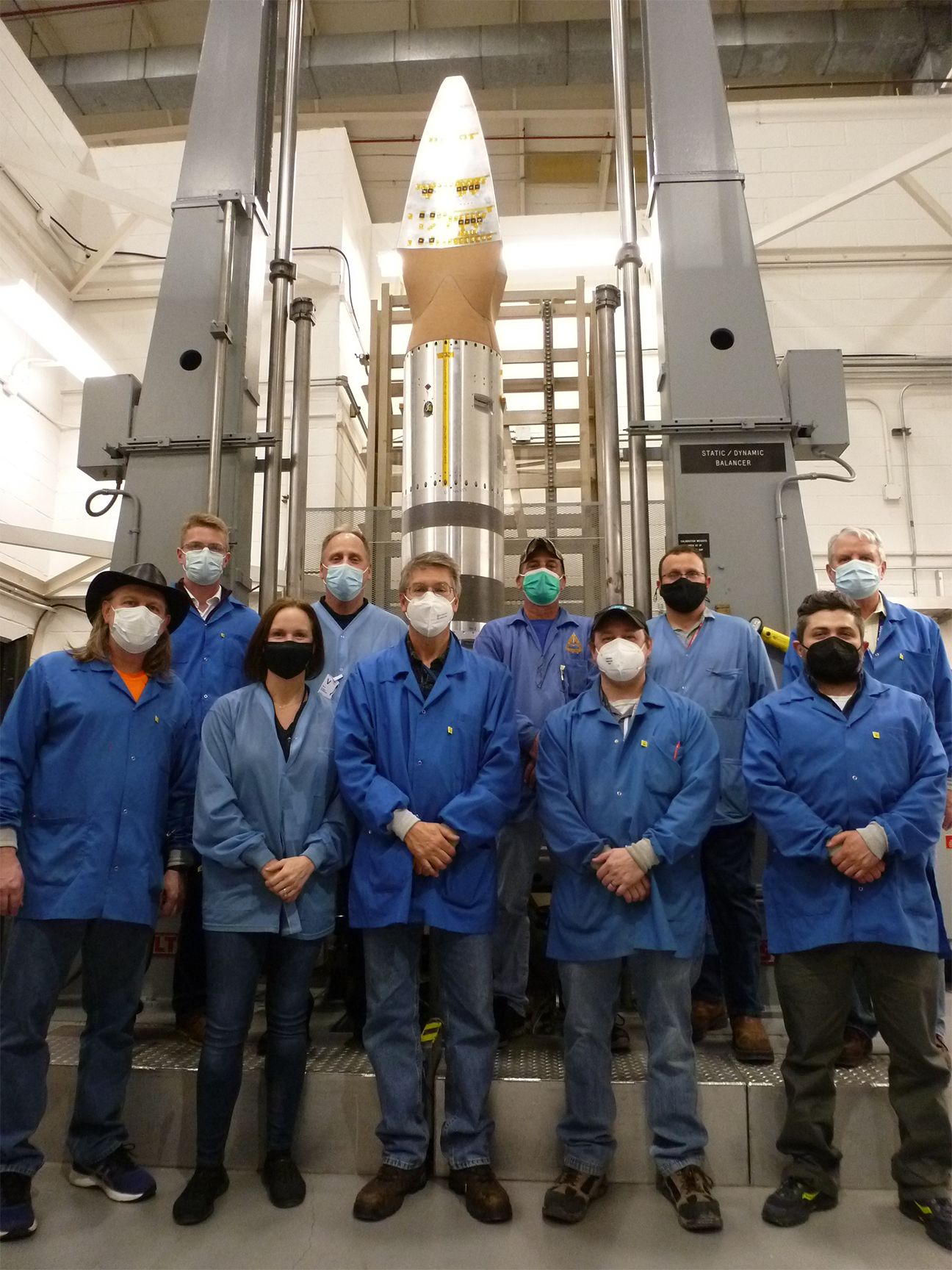
Part of the BOLT II team: (Back row left to right) John Wirth (Texas A&M student), Rodney Bowersox (BOLT II PI and Texas A&M professor), John Peterson (NASA WFF Mechanical Technician), Robert Davidson (NASA WFF Electrical Technician), Ted Gass (NASA Wallops Flight Facility and BOLT II Mission Manager). (Front row left to right) John Gsell (NASA WFF Electrical Engineer), Sarah Popkin (AFOSR PO), Dave Adamczak (Aerospace Systems Directorate), Nate Wroblewski (NASA WFF Environmental Lab Engineer), Jim Tancred (Aerospace Systems Directorate) (Courtesy Photo)
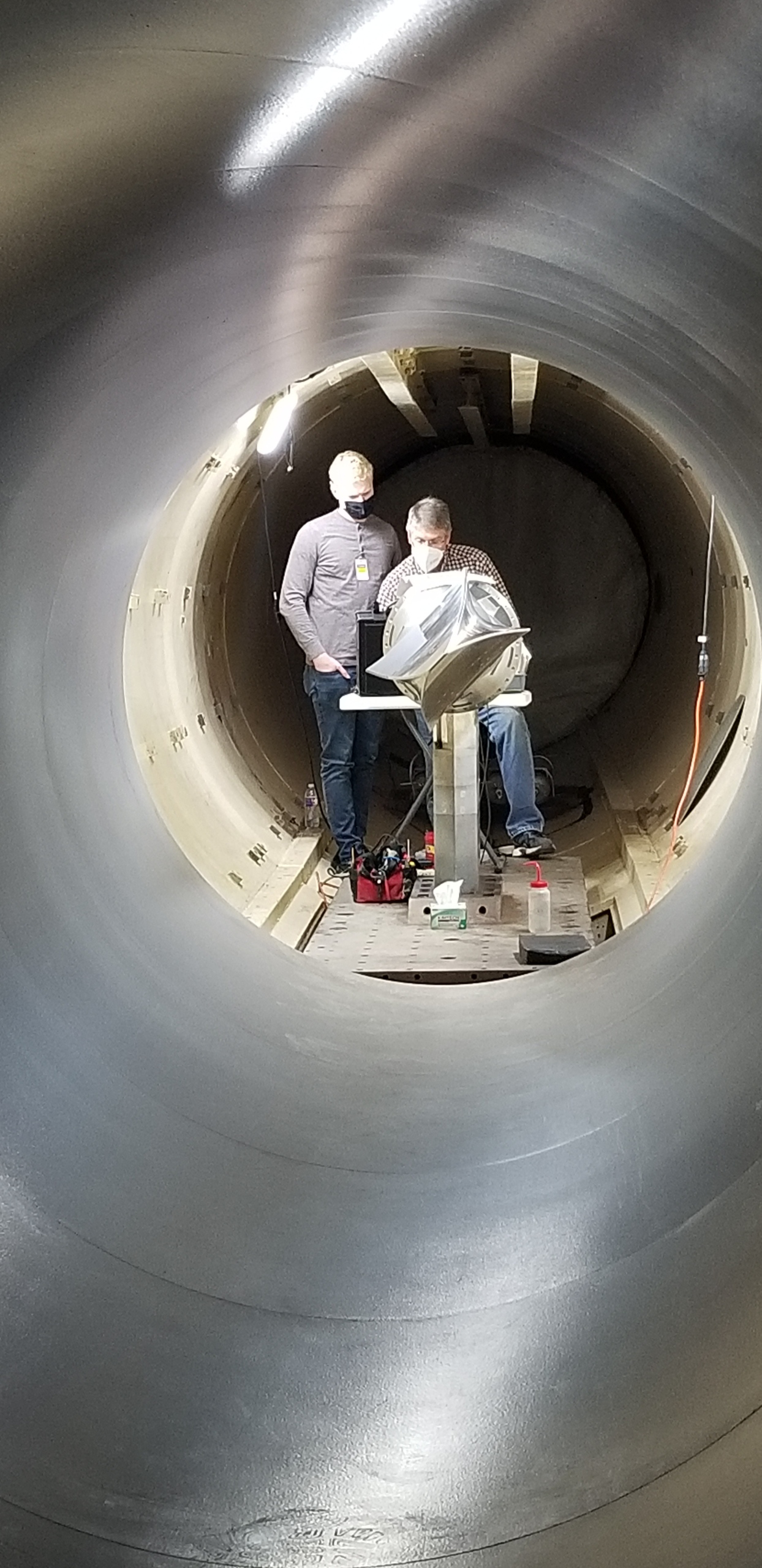
Josh Day and Dave Adamczak of AFRL’s Aerospace Systems Directorate by BOLT II, installed in the CUBRC LENS II wind tunnel for the first-ever pre-test of a flight vehicle in the expected flight conditions. (Courtesy photo)
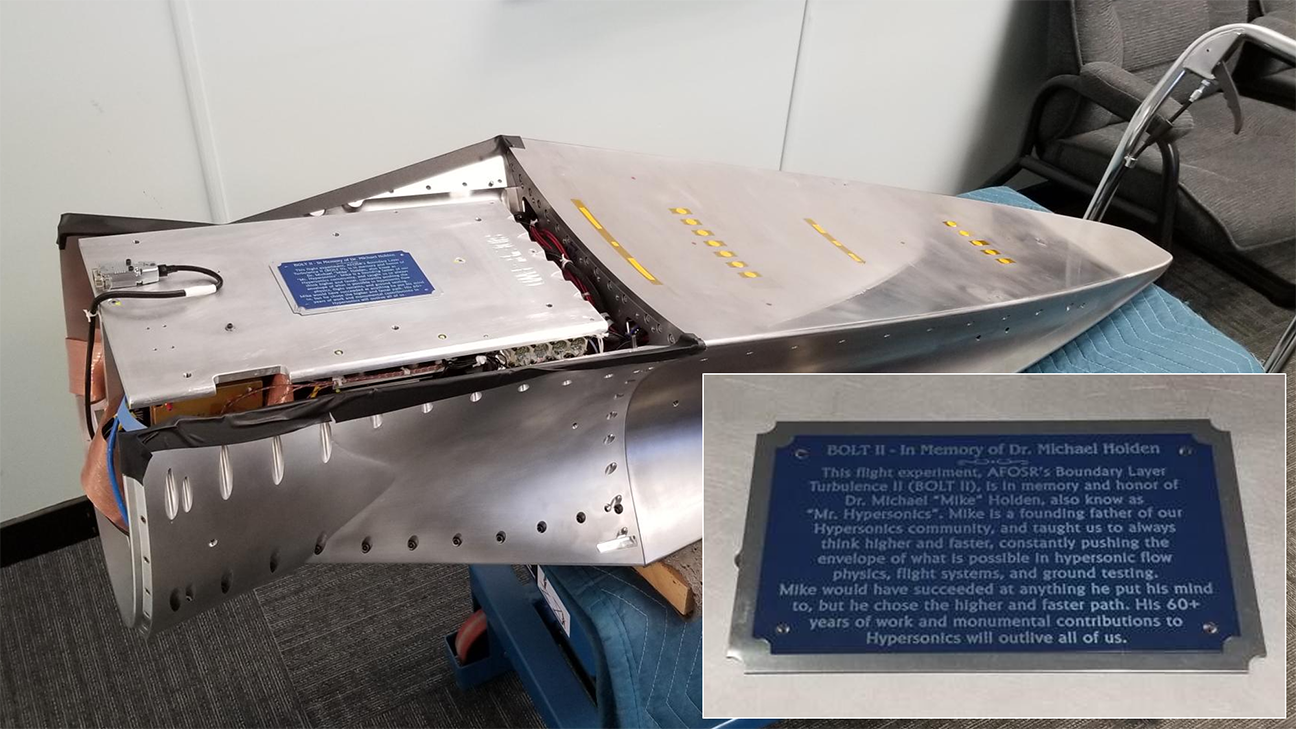
The BOLT II payload in the March 21 flight experiment will carry a plaque dedicating the flight to the late Mike Holden, who was a major contributor to the field of hypersonics. (Courtesy Photo)
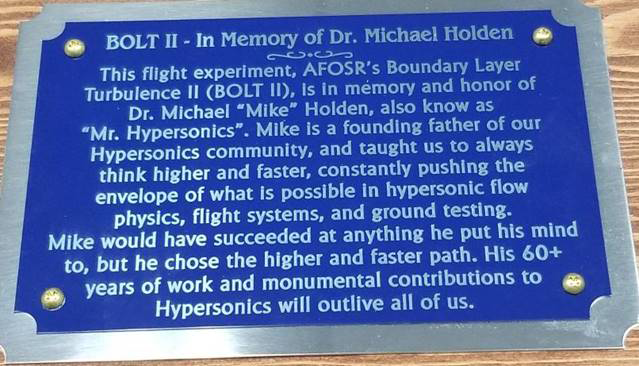
A plaque dedicating the BOLT II flight to the late Mike Holden, who was a major contributor to the field of hypersonics. (Courtesy Photo)
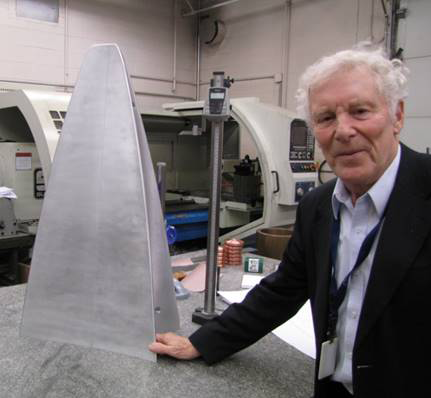
Mike Holden with BOLT. With more than 60 years in the hypersonics field of study, Mike Holden brought major contributions to understanding to the BOLT experimentation program. (Courtesy Photo)
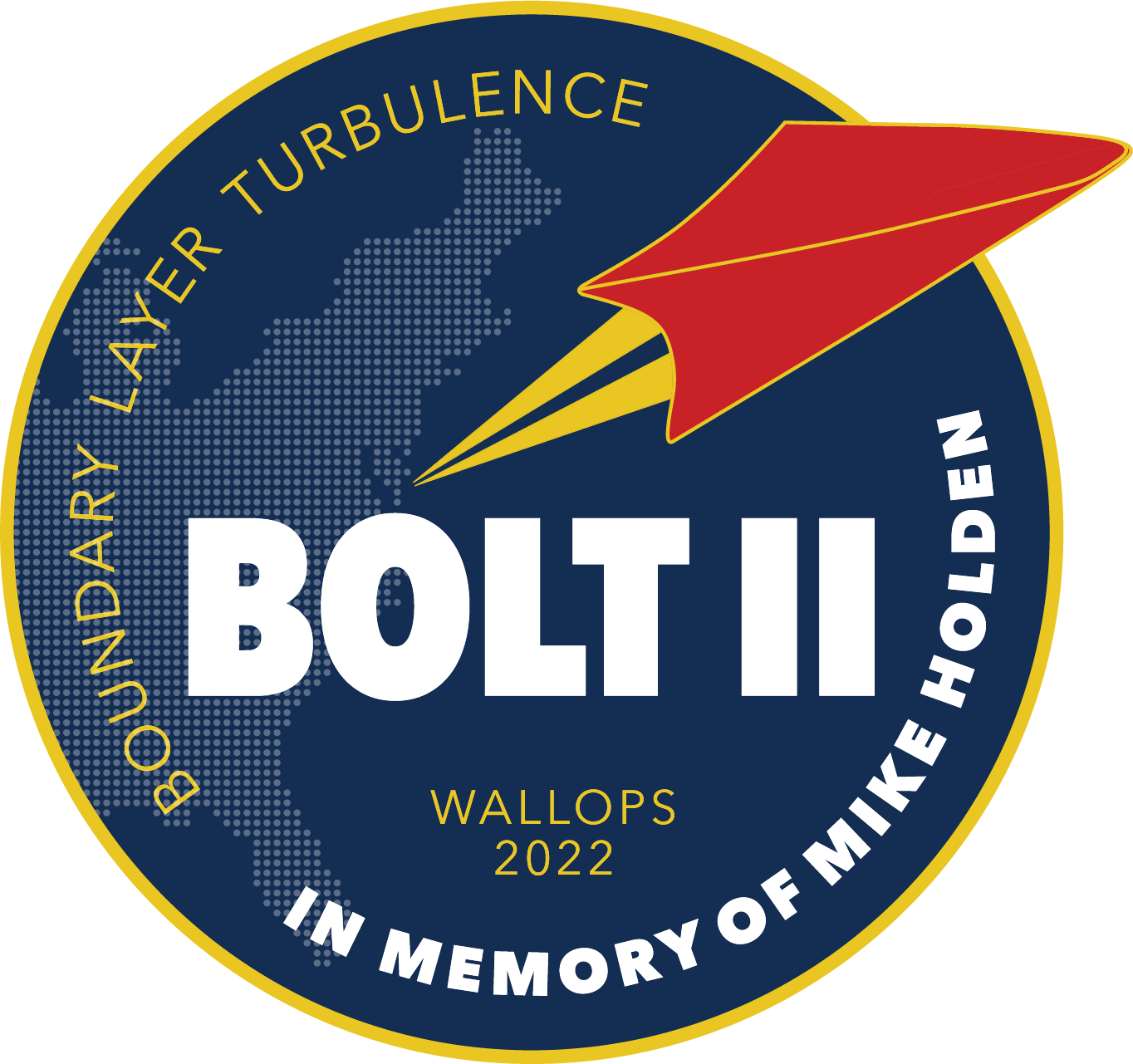
The goals of the AFOSR BOLT flight experiments are to collect scientific data to better understand boundary layer transition (BOLT) and turbulence (BOLT II) during hypersonic flight. (Courtesy graphic)
